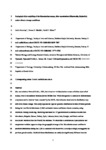Ecological niche modeling of the Macedonian mouse, Mus macedonicus (Mammalia, Rodentia), under climate change conditions
| dc.contributor.author | Dermitas, S | |
| dc.contributor.author | Gunduz, NE | |
| dc.contributor.author | Bilton, David | |
| dc.date.accessioned | 2022-12-02T12:04:40Z | |
| dc.date.issued | 2022-12-08 | |
| dc.identifier.issn | 2224-4662 | |
| dc.identifier.issn | 2224-4662 | |
| dc.identifier.uri | http://hdl.handle.net/10026.1/20044 | |
| dc.description.abstract |
Mus macedonicus Petrov & Ružic, 1983, also known as the Macedonian mouse or Balkan short-tailed mouse, lives in the southern Balkans and the Middle East. While this species is common in Mediterranean ecosystems and is listed as “least concern” by the IUCN, little is known about how its distribution may shift with climate change. This study explores the ‘species’ potential distribution in three different periods: during the Last Glacial Maximum (LGM) and under current and future climate scenarios, using Maximum Entropy modelling. Modelling was based on 137 georeferenced occurrence records from Macedonia, Bulgaria, Greece, Turkey, Syria, Lebanon, Israel, Iran, Georgia, and Russia and ten bioclimatic variables from the WorldClim database. We show that a combination of precipitation and temperature variables appear to shape the geographical range of the Macedonian mouse and that its predicted distribution during the LGM is consistent with its survival in multiple refugia, as suggested by previous genetic studies. Modelled future distributions are subtly but significantly different from the current, with population losses and gains in different regions. Our results provide a sound framework for future studies on this model species’ range dynamics, suggesting that the overall geographical range of M. macedonicus is relatively stable in the long term. | |
| dc.format.extent | 28-36 | |
| dc.language.iso | en | |
| dc.publisher | Brill Academic Publishers | |
| dc.subject | bioclimatic variables | |
| dc.subject | ecological niche modelling | |
| dc.subject | jackknife test | |
| dc.subject | MaxEnt | |
| dc.subject | Mediterranean climate zone | |
| dc.title | Ecological niche modeling of the Macedonian mouse, Mus macedonicus (Mammalia, Rodentia), under climate change conditions | |
| dc.type | journal-article | |
| dc.type | Journal Article | |
| plymouth.author-url | https://www.webofscience.com/api/gateway?GWVersion=2&SrcApp=PARTNER_APP&SrcAuth=LinksAMR&KeyUT=WOS:001054546600001&DestLinkType=FullRecord&DestApp=ALL_WOS&UsrCustomerID=11bb513d99f797142bcfeffcc58ea008 | |
| plymouth.issue | 1-2 | |
| plymouth.volume | 69 | |
| plymouth.publication-status | Published | |
| plymouth.journal | Israel Journal of Ecology and Evolution | |
| dc.identifier.doi | 10.1163/22244662-bja10044 | |
| plymouth.organisational-group | /Plymouth | |
| plymouth.organisational-group | /Plymouth/Faculty of Science and Engineering | |
| plymouth.organisational-group | /Plymouth/Faculty of Science and Engineering/School of Biological and Marine Sciences | |
| plymouth.organisational-group | /Plymouth/REF 2021 Researchers by UoA | |
| plymouth.organisational-group | /Plymouth/REF 2021 Researchers by UoA/UoA07 Earth Systems and Environmental Sciences | |
| plymouth.organisational-group | /Plymouth/Research Groups | |
| plymouth.organisational-group | /Plymouth/Research Groups/Marine Institute | |
| plymouth.organisational-group | /Plymouth/Users by role | |
| plymouth.organisational-group | /Plymouth/Users by role/Academics | |
| dcterms.dateAccepted | 2022-10-09 | |
| dc.rights.embargodate | 2022-12-22 | |
| dc.identifier.eissn | 2224-4662 | |
| rioxxterms.versionofrecord | 10.1163/22244662-bja10044 | |
| rioxxterms.licenseref.uri | http://www.rioxx.net/licenses/all-rights-reserved | |
| rioxxterms.type | Journal Article/Review |


